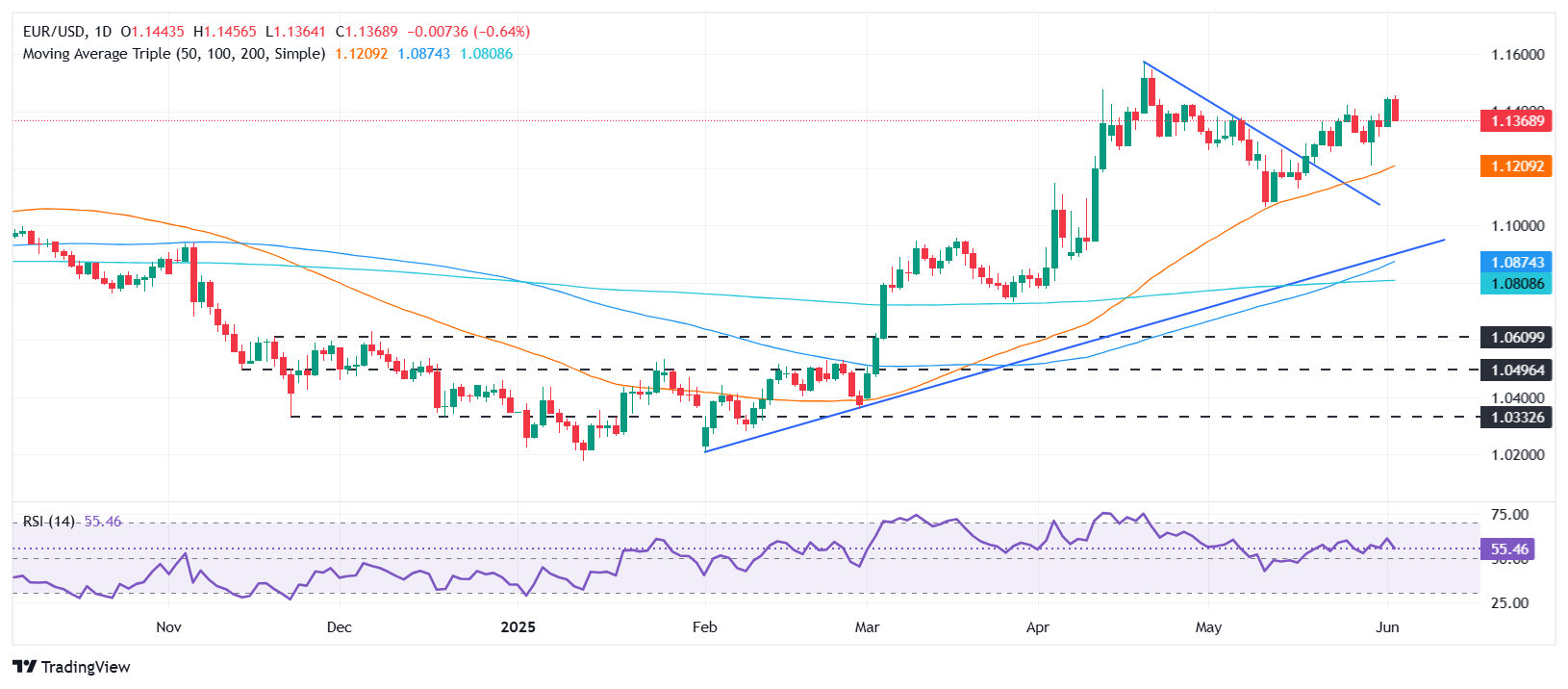EUR/USD tumbles below 1.14 on US data as trade tensions resurface
- EUR/USD falls to 1.1379 as the US labor market shows strength, boosting DXY after recent weakness.
- Trump set to speak with Xi; plans to double steel and aluminum tariffs fuel global trade fears.
- Soft Eurozone inflation reinforces expectations for ECB rate cut at upcoming policy meeting.
EUR/USD retreats after hitting a six-week peak of 1.1454 on Tuesday amid increasing concerns of market participants regarding the trade war ignited by the United States (US). The Greenback’s appreciation weighs on the pair, which trades at 1.1379, down 0.52%.
Wall Street remains in the green as news emerged that US President Donald Trump is reportedly set to speak with Chinese President Xi Jinping this week, according to Reuters sources.
Data from the United States lifted the US Dollar (USD), which has been battered and lost nearly 2% this week, according to the US Dollar Index (DXY). April’s US Job Openings and Labor Turnover Survey (JOLTS) was better than expected, hinting that the labor market is solid. Meanwhile, Factory Orders fell sharply in April as manufacturing activity is pressured due to US President Donald Trump’s tariffs.
Uncertainty about US trade policies is also a reason behind the decline of the EUR/USD pair. The White House Press Secretary Karoline Leavitt said that the trade offer deadlines can confirm the letter is authentic and on track to good deals. She added that President Trump will sign an executive order to double tariffs on steel and aluminum on Tuesday, which will take effect on Wednesday.
Across the pond, the Eurozone Harmonized Index of Consumer Prices (HICP) inflation data for May fell below the European Central Bank (ECB) objective. This reaffirms expectations that the ECB might cut rates this week, a path that began last June.
In the Eurozone, the docket will feature the European Central Bank monetary policy decision and ECB President Christine Lagarde’s press conference. In the US, the schedule is packed with employment data, with the ADP National Employment Change for May awaited on Wednesday, followed by Initial Jobless Claims for the week ending May 31 and May’s Nonfarm Payrolls figures.
EUR/USD daily market movers: Euro retreats below 1.1400 on US JOLTS report
- EUR/USD uptrend remains intact, but it would be adrift to US and Eurozone economic data during the week.
- The US JOLTS Job Openings unexpectedly rose to 7.39 million in April, up from 7.20 million (revised) in March, defying expectations for a drop to 7.10 million, signaling ongoing labor market resilience.
- US Factory orders dropped 3.7% in April, down from a 4.3% jump in March, the US Commerce Department revealed on Tuesday. Economists surveyed by Reuters expected orders to drop by 3.1%.
- Federal Reserve officials crossed the wires. Governor Lisa Cook said that the policy is well-positioned for a range of scenarios and anticipates higher inflation and slower activity due to tariffs. Chicago’s Fed President, Austan Goolsbee, said the Fed has to wait and see if the impact of tariffs on inflation is small or big.
- The Eurozone HICP in May fell by 1.9%, below the ECB’s 2% target for the first time in eight months. Excluding volatile items, the so-called core HICP fell by 2.3% YoY, down from 2.7% in the previous month.
- Financial market players had fully priced in the expectation that the ECB would reduce its Deposit Facility Rate by 25 basis points (bps) to 2% at the upcoming monetary policy meeting.
Euro technical outlook: EUR/USD cracks below 1.1400, bears eye 1.1300
EUR/USD is upward biased, as depicted by the daily chart, despite the ongoing pullback. The Relative Strength Index (RSI) is bullish, but it begins to show signs that it’s losing steam, opening the door for a deeper retracement.
If EUR/USD falls below the June 2 daily low of 1.1344, it could clear the path to challenge the 1.1300 level. A breach of the latter would expose the 20-day Simple Moving Average (SMA) at 1.1278, followed by the 50-day SMA at 1.1218. On further weakness, expect a test of 1.1200.
Conversely, if EUR/USD climbs past 1.1400,buyers could test the weekly peak of 1.1454, followed by the April 21 year-to-date (YTD) peak at 1.1573.

Euro FAQs
The Euro is the currency for the 19 European Union countries that belong to the Eurozone. It is the second most heavily traded currency in the world behind the US Dollar. In 2022, it accounted for 31% of all foreign exchange transactions, with an average daily turnover of over $2.2 trillion a day. EUR/USD is the most heavily traded currency pair in the world, accounting for an estimated 30% off all transactions, followed by EUR/JPY (4%), EUR/GBP (3%) and EUR/AUD (2%).
The European Central Bank (ECB) in Frankfurt, Germany, is the reserve bank for the Eurozone. The ECB sets interest rates and manages monetary policy. The ECB’s primary mandate is to maintain price stability, which means either controlling inflation or stimulating growth. Its primary tool is the raising or lowering of interest rates. Relatively high interest rates – or the expectation of higher rates – will usually benefit the Euro and vice versa. The ECB Governing Council makes monetary policy decisions at meetings held eight times a year. Decisions are made by heads of the Eurozone national banks and six permanent members, including the President of the ECB, Christine Lagarde.
Eurozone inflation data, measured by the Harmonized Index of Consumer Prices (HICP), is an important econometric for the Euro. If inflation rises more than expected, especially if above the ECB’s 2% target, it obliges the ECB to raise interest rates to bring it back under control. Relatively high interest rates compared to its counterparts will usually benefit the Euro, as it makes the region more attractive as a place for global investors to park their money.
Data releases gauge the health of the economy and can impact on the Euro. Indicators such as GDP, Manufacturing and Services PMIs, employment, and consumer sentiment surveys can all influence the direction of the single currency. A strong economy is good for the Euro. Not only does it attract more foreign investment but it may encourage the ECB to put up interest rates, which will directly strengthen the Euro. Otherwise, if economic data is weak, the Euro is likely to fall. Economic data for the four largest economies in the euro area (Germany, France, Italy and Spain) are especially significant, as they account for 75% of the Eurozone’s economy.
Another significant data release for the Euro is the Trade Balance. This indicator measures the difference between what a country earns from its exports and what it spends on imports over a given period. If a country produces highly sought after exports then its currency will gain in value purely from the extra demand created from foreign buyers seeking to purchase these goods. Therefore, a positive net Trade Balance strengthens a currency and vice versa for a negative balance.

